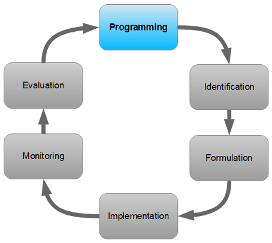Programming
 The programming phase establishes the link between the individual project and the overall strategy of the organisation. How does the NGO or development actor want to realise the main purpose of the organisation (as expressed in its vision and mission for instance) over the next couple of years? To answer this question, many organisations go through a participatory process with their beneficiaries and with other stakeholders. This often leads to some kind of long term strategy document, that contains general orientations about what activities and projects the organisation will do, in which countries or regions, with what target groups and counting on what means (own resources, donor funding, etc.)
The programming phase establishes the link between the individual project and the overall strategy of the organisation. How does the NGO or development actor want to realise the main purpose of the organisation (as expressed in its vision and mission for instance) over the next couple of years? To answer this question, many organisations go through a participatory process with their beneficiaries and with other stakeholders. This often leads to some kind of long term strategy document, that contains general orientations about what activities and projects the organisation will do, in which countries or regions, with what target groups and counting on what means (own resources, donor funding, etc.)
Some organisations limit this reflection to their activities in the field. Other take a step further and develop a long term vision for all aspects of their work: human resources management, financial management, quality management, external communications strategy, lobbying strategy and so on.
Often, the organisation’s strategy will fit into a broader vision, for instance common policies developed with the NGO sector in your country. This may also lead to specific thematic or country policies that are added to the overall strategy and that explain how the organisation will implement these policies over the next couple of years (for instance a gender strategy, a food security strategy, a country strategy, an ecological durability strategy, etc.)
At this step, the organisation may also develop common tools or approaches that will be used in the coming years. These may include practical guidelines that can be used for the different projects, or lists with criteria (for instance for the selection of partner organisations or beneficiaries) and other tools.
All this doesn’t come out of the blue. The idea behind the project cycle is that these reflections are fed by the lessons learned from previous projects, amongst other things through evaluations but also by asking those who were involved to participate in this phase.





Add new comment